押韵字FREE_Rhyming_Words_Mat
- 格式:pdf
- 大小:52.21 KB
- 文档页数:1
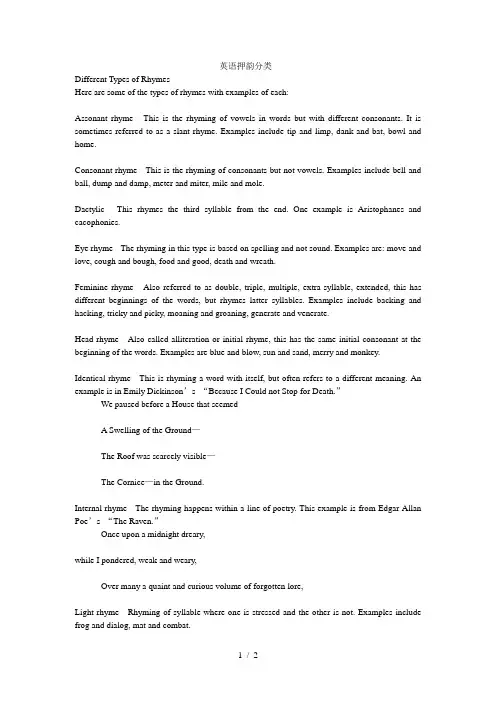
英语押韵分类Different Types of RhymesHere are some of the types of rhymes with examples of each:Assonant rhyme - This is the rhyming of vowels in words but with different consonants. It is sometimes referred to as a slant rhyme. Examples include tip and limp, dank and bat, bowl and home.Consonant rhyme - This is the rhyming of consonants but not vowels. Examples include bell and ball, dump and damp, meter and miter, mile and mole.Dactylic - This rhymes the third syllable from the end. One example is Aristophanes and cacophonies.Eye rhyme - The rhyming in this type is based on spelling and not sound. Examples are: move and love, cough and bough, food and good, death and wreath.Feminine rhyme - Also referred to as double, triple, multiple, extra-syllable, extended, this has different beginnings of the words, but rhymes latter syllables. Examples include backing and hacking, tricky and picky, moaning and groaning, generate and venerate.Head rhyme - Also called alliteration or initial rhyme, this has the same initial consonant at the beginning of the words. Examples are blue and blow, sun and sand, merry and monkey.Identical rhyme - This is rhyming a word with itself, but often refers to a different meaning. An example is in Emily Dickinson’s “Because I Could not Stop for Death.”We paused before a House that seemedA Swelling of the Ground—The Roof was scarcely visible—The Cornice—in the Ground.Internal rhyme - The rhyming happens within a line of poetry. This example is from Edgar Allan Poe’s “The Raven.”Once upon a midnight dreary,while I pondered, weak and weary,Over many a quaint and curious volume of forgotten lore,Light rhyme - Rhyming of syllable where one is stressed and the other is not. Examples include frog and dialog, mat and combat.Macaronic rhyme - This rhymes words from different languages. Examples are villa and manilla, amore and favor, sure and kreatur, lay and lei, sitar and guitar.Masculine rhyme - In this rhyme, the stress in on the final syllable in both words. Examples include support and report, dime and sublime, divulge and bulge.Near rhyme - Also referred to as half, slant, approximate, off, and oblique, this rhymes the final consonants but not the vowels or initial consonants. Examples are bent and rant, quick and back.Oblique - This is an imperfect rhyme because the sounds do not quite match. Sometimes these are called half, approximate, near, off, or slant rhymes. Examples are lap and shape, fiend and mean, gun and thumb.Perfect rhyme - Sometimes called exact, full or true, this rhyme is the typical rhyme where the ending sounds match. Examples are cat and hat, egg and beg, ink and pink, boo and true, soap and dope.Rich rhyme - In this case, the words are pronounced the same but have different meanings, like homonyms. Examples include raise and raze, break and brake, vary and very, lessen and lesson.Scarce rhyme - This refers to words that have very few other words that rhyme with them. Examples are lips and whisp, oceanless and motionless.Semirhyme - In this rhyme, one word has and extra syllable. Examples are mend and ending, rye and buying, lick and pickle.Syllabic - Rhyming the last syllable, this is also called tail or end rhyme. Examples include beaver and silver, dancing and prancing.Wrenched rhyme - This is an imperfect rhyme which rhymes a stressed with an unstressed syllable. Examples are caring and wing, lady and a bee.。

world押韵摘要:1.押韵的定义和作用2.押韵的种类a.尾韵b.头韵c.内韵3.押韵在中文诗歌中的运用4.押韵在歌词和口语中的运用5.押韵的技巧和注意事项正文:押韵是指在诗歌、歌词或口语中,将某些词汇或句子的末尾音韵相互搭配,使其读起来和谐、优美。
押韵不仅让文本更具节奏感,还能增强表达力,更好地传达作者的情感和思想。
押韵主要分为三种类型:尾韵、头韵和内韵。
尾韵,又称尾音押韵,是指诗句或句子的最后一个字的韵部相同。
这是最常见的押韵方式,如:“床前明月光,疑是地上霜。
”头韵,又称声母押韵,是指诗句或句子中第一个字的声母相同。
如:“春暖花开,蜜蜂采蜜忙。
”内韵,又称中间韵,是指诗句或句子中中间某个字的韵部相同。
如:“江南可采莲,莲叶何田田。
”押韵在中文诗歌中有着举足轻重的地位。
从《诗经》到唐诗、宋词、元曲,乃至现代诗歌,押韵都是诗人表现手法的重要一环。
通过巧妙运用押韵,诗人们创造出许多优美的诗篇,给人以极大的艺术享受。
在歌词和口语中,押韵也得到了广泛运用。
押韵可以使歌词更具旋律感,与音乐完美融合。
同时,在口语表达中,押韵往往能让表达更加生动、幽默,让人印象深刻。
在运用押韵时,需要注意以下几点技巧和事项:1.保持押韵的和谐与自然。
避免生硬、勉强地搭配韵脚,以免影响文本的整体效果。
2.注意押韵的分布。
适当的押韵间距能让文本更具节奏感,避免过多或过密的押韵,以免显得单调乏味。
3.选择合适的韵脚。
要根据文本的题材、风格和情感,选择恰当的韵脚,以增强表达力。
总之,押韵作为诗歌、歌词和口语中的一种重要修辞手法,既体现了作者对文字的驾驭能力,也为读者带来了愉悦的阅读体验。
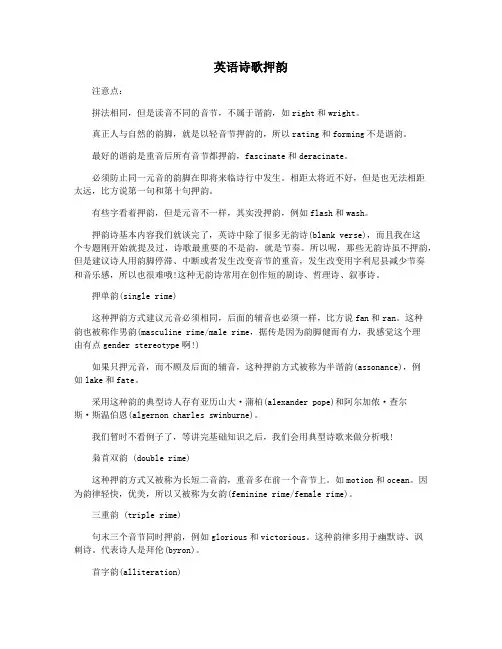
英语诗歌押韵注意点:拼法相同,但是读音不同的音节,不属于谐韵,如right和wright。
真正人与自然的韵脚,就是以轻音节押韵的,所以rating和forming不是谐韵。
最好的谐韵是重音后所有音节都押韵,fascinate和deracinate。
必须防止同一元音的韵脚在即将来临诗行中发生。
相距太将近不好,但是也无法相距太远,比方说第一句和第十句押韵。
有些字看着押韵,但是元音不一样,其实没押韵,例如flash和wash。
押韵诗基本内容我们就谈完了,英诗中除了很多无韵诗(blank verse),而且我在这个专题刚开始就提及过,诗歌最重要的不是韵,就是节奏。
所以呢,那些无韵诗虽不押韵,但是建议诗人用韵脚停滞、中断或者发生改变音节的重音,发生改变用字利尼县减少节奏和音乐感,所以也很难哦!这种无韵诗常用在创作短的剧诗、哲理诗、叙事诗。
押单韵(single rime)这种押韵方式建议元音必须相同,后面的辅音也必须一样,比方说fan和ran。
这种韵也被称作男韵(masculine rime/male rime,据传是因为韵脚健而有力,我感觉这个理由有点gender stereotype啊!)如果只押元音,而不顾及后面的辅音,这种押韵方式被称为半谐韵(assonance),例如lake和fate。
采用这种韵的典型诗人存有亚历山大·蒲柏(alexander pope)和阿尔加侬·查尔斯·斯温伯恩(algernon charles swinburne)。
我们暂时不看例子了,等讲完基础知识之后,我们会用典型诗歌来做分析哦!枭首双韵 (double rime)这种押韵方式又被称为长短二音韵,重音多在前一个音节上。
如motion和ocean。
因为韵律轻快,优美,所以又被称为女韵(feminine rime/female rime)。
三重韵 (triple rime)句末三个音节同时押韵,例如glorious和victorious。
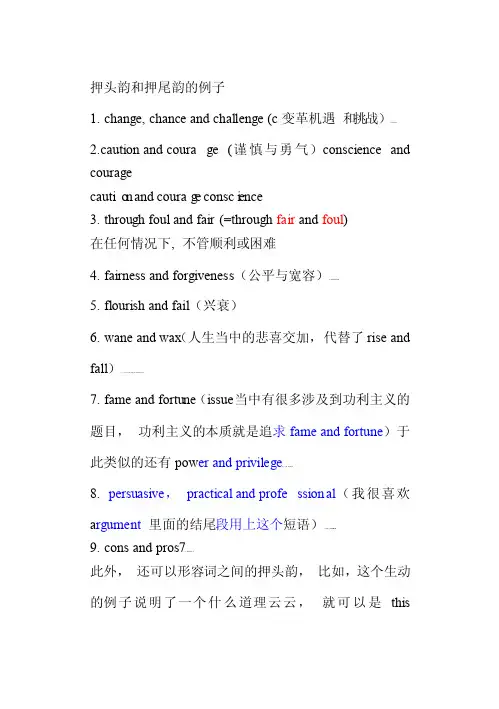
押头韵和押尾韵的例子
1. change, chance and challe nge (c变革机遇和挑战)
2.cautio n and courag e (谨慎与勇气)consci enceand courag e
cautio n and courag e consci ence
3. throug h foul and fair (=throug h fair and foul)
在任何情况下, 不管顺利或困难
4. fairness and forgiv eness(公平与宽容)
5. flouri sh and fail(兴衰)
6. wane and wax(人生当中的悲喜交加,代替了ris e and fall)
7. fame and fortun e(issue当中有很多涉及到功利主义的题目,功利主义的本质就是追求 fame and fortun e)于此类似的还有powe r and privil ege
8.persua sive,practi cal and profes siona l(我很喜欢ar gumen t 里面的结尾段用上这个短语)
9. cons and pros7
此外,还可以形容词之间的押头韵,比如,这个生动的例子说明了一个什么道理云云,就可以是this
intens ely intrig uingillust ratio n inspir es that。
murdered and maimed。
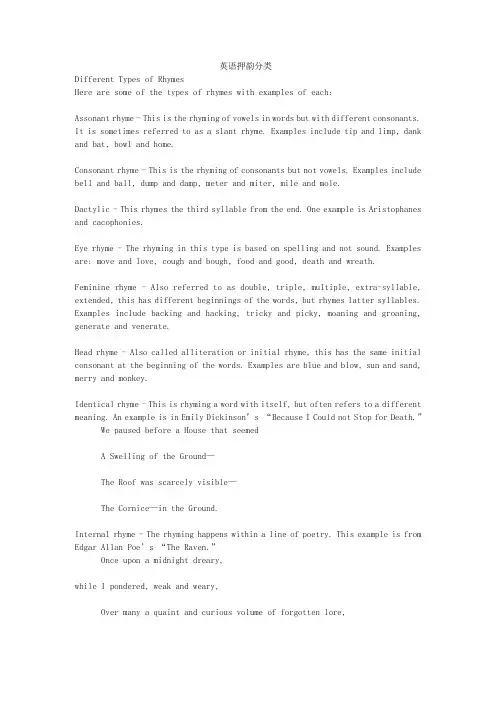
英语押韵分类Different Types of RhymesHere are some of the types of rhymes with examples of each:Assonant rhyme - This is the rhyming of vowels in words but with different consonants. It is sometimes referred to as a slant rhyme. Examples include tip and limp, dank and bat, bowl and home.Consonant rhyme - This is the rhyming of consonants but not vowels. Examples include bell and ball, dump and damp, meter and miter, mile and mole.Dactylic - This rhymes the third syllable from the end. One example is Aristophanes and cacophonies.Eye rhyme - The rhyming in this type is based on spelling and not sound. Examples are: move and love, cough and bough, food and good, death and wreath.Feminine rhyme - Also referred to as double, triple, multiple, extra-syllable, extended, this has different beginnings of the words, but rhymes latter syllables. Examples include backing and hacking, tricky and picky, moaning and groaning, generate and venerate.Head rhyme - Also called alliteration or initial rhyme, this has the same initial consonant at the beginning of the words. Examples are blue and blow, sun and sand, merry and monkey.Identical rhyme - This is rhyming a word with itself, but often refers to a different meaning. An example is in Emily Dickinson’s “Because I Could not Stop for Death.” We paused before a House that seemedA Swelling of the Ground—The Roof was scarcely visible—The Cornice—in the Ground.Internal rhyme - The rhyming happens within a line of poetry. This example is from Edgar Allan Poe’s “The Raven.”Once upon a midnight dreary,while I pondered, weak and weary,Over many a quaint and curious volume of forgotten lore,Light rhyme - Rhyming of syllable where one is stressed and the other is not. Examples include frog and dialog, mat and combat.Macaronic rhyme - This rhymes words from different languages. Examples are villa and manilla, amore and favor, sure and kreatur, lay and lei, sitar and guitar.Masculine rhyme - In this rhyme, the stress in on the final syllable in both words. Examples include support and report, dime and sublime, divulge and bulge.Near rhyme - Also referred to as half, slant, approximate, off, and oblique, this rhymes the final consonants but not the vowels or initial consonants. Examples are bent and rant, quick and back.Oblique - This is an imperfect rhyme because the sounds do not quite match. Sometimes these are called half, approximate, near, off, or slant rhymes. Examples are lap and shape, fiend and mean, gun and thumb.Perfect rhyme - Sometimes called exact, full or true, this rhyme is the typical rhyme where the ending sounds match. Examples are cat and hat, egg and beg, ink and pink, boo and true, soap and dope.Rich rhyme - In this case, the words are pronounced the same but have different meanings, like homonyms. Examples include raise and raze, break and brake, vary and very, lessen and lesson.Scarce rhyme - This refers to words that have very few other words that rhyme with them. Examples are lips and whisp, oceanless and motionless.Semirhyme - In this rhyme, one word has and extra syllable. Examples are mend and ending, rye and buying, lick and pickle.Syllabic - Rhyming the last syllable, this is also called tail or end rhyme. Examples include beaver and silver, dancing and prancing.Wrenched rhyme - This is an imperfect rhyme which rhymes a stressed with an unstressed syllable. Examples are caring and wing, lady and a bee.(素材和资料部分来自网络,供参考。
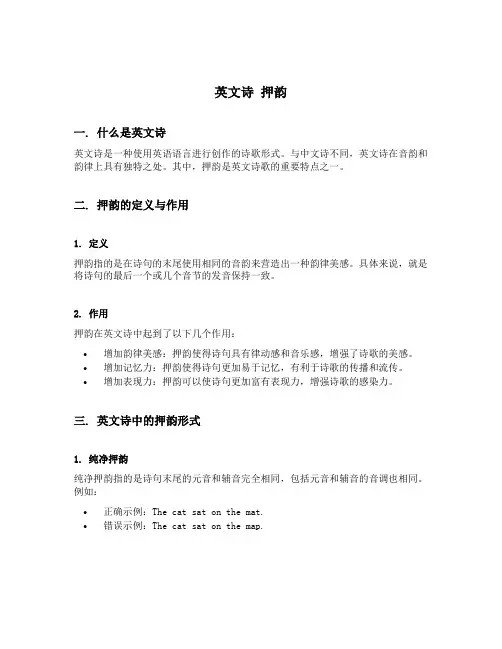
英文诗押韵一. 什么是英文诗英文诗是一种使用英语语言进行创作的诗歌形式。
与中文诗不同,英文诗在音韵和韵律上具有独特之处。
其中,押韵是英文诗歌的重要特点之一。
二. 押韵的定义与作用1. 定义押韵指的是在诗句的末尾使用相同的音韵来营造出一种韵律美感。
具体来说,就是将诗句的最后一个或几个音节的发音保持一致。
2. 作用押韵在英文诗中起到了以下几个作用:•增加韵律美感:押韵使得诗句具有律动感和音乐感,增强了诗歌的美感。
•增加记忆力:押韵使得诗句更加易于记忆,有利于诗歌的传播和流传。
•增加表现力:押韵可以使诗句更加富有表现力,增强诗歌的感染力。
三. 英文诗中的押韵形式1. 纯净押韵纯净押韵指的是诗句末尾的元音和辅音完全相同,包括元音和辅音的音调也相同。
例如:•正确示例:The cat sat on the mat.•错误示例:The cat sat on the map.2. 终韵押韵终韵押韵指的是诗句末尾的辅音相同,元音可能不同,但音调相同。
例如:•正确示例:He ate eight plates.•错误示例:He ate eight flats.3. 零韵押韵零韵押韵指的是诗句末尾没有押韵。
这种押韵形式在英文诗中也是常见的。
例如:•正确示例:The sun shines bright.•错误示例:The sun shines light.四. 英文诗中的押韵技巧1. 选择合适的词汇在进行押韵时,需要选择合适的词汇。
可以利用在线诗歌辞典或押韵词典来寻找押韵的词组或单词。
同时,还要注意词汇的意义和上下文的连贯性。
2. 引入半韵为了使诗句更加流畅和自然,可以引入半韵。
半韵指的是在诗句中使用部分相同的音韵,而不是完全相同。
这样可以增加一些变化和变化,使诗句更加富有层次感和多样性。
3. 利用节奏和音调除了押韵,还可以利用诗歌的节奏和音调来增加诗句的美感。
可以通过改变音节的重音、使用不同的音调或增加停顿来创造出不同的韵律效果。
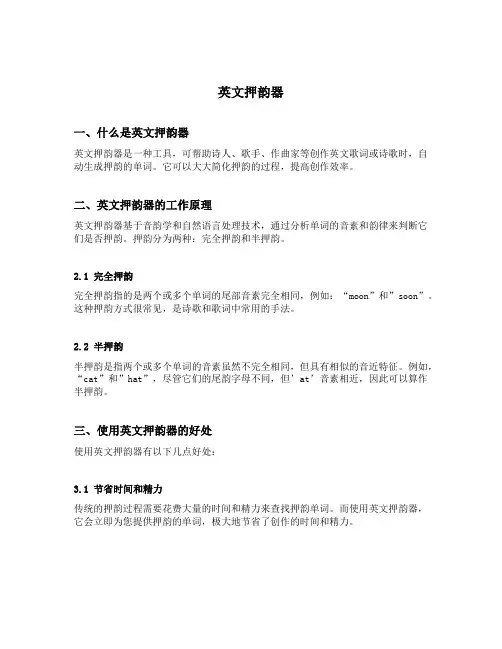
英文押韵器一、什么是英文押韵器英文押韵器是一种工具,可帮助诗人、歌手、作曲家等创作英文歌词或诗歌时,自动生成押韵的单词。
它可以大大简化押韵的过程,提高创作效率。
二、英文押韵器的工作原理英文押韵器基于音韵学和自然语言处理技术,通过分析单词的音素和韵律来判断它们是否押韵。
押韵分为两种:完全押韵和半押韵。
2.1 完全押韵完全押韵指的是两个或多个单词的尾部音素完全相同,例如:“moon”和”soon”。
这种押韵方式很常见,是诗歌和歌词中常用的手法。
2.2 半押韵半押韵是指两个或多个单词的音素虽然不完全相同,但具有相似的音近特征。
例如,“cat”和”hat”,尽管它们的尾韵字母不同,但’at’音素相近,因此可以算作半押韵。
三、使用英文押韵器的好处使用英文押韵器有以下几点好处:3.1 节省时间和精力传统的押韵过程需要花费大量的时间和精力来查找押韵单词。
而使用英文押韵器,它会立即为您提供押韵的单词,极大地节省了创作的时间和精力。
3.2 提高押韵的准确性对于那些不太熟悉英语押韵规则的人来说,使用英文押韵器可以确保押韵的准确性。
它会基于专业的算法,帮助您找到最佳的押韵单词。
3.3 拓宽创作思路有时候,我们可能会陷入创作的困境,无法找到合适的押韵单词。
英文押韵器可以提供各种各样的押韵选择,帮助我们在创作过程中拓宽思路,找到更多创作灵感。
四、英文押韵器的应用场景英文押韵器广泛应用于以下领域:4.1 歌曲创作在创作流行歌曲时,押韵是非常重要的。
使用英文押韵器可以帮助作曲家和歌手快速找到押韵的单词,使歌曲更加富有韵律感和吸引力。
4.2 诗歌写作诗歌需要具备鲜明的节奏感和韵律。
英文押韵器可以帮助诗人寻找最佳的押韵单词,使诗歌更加饱满、优美。
4.3 广告文案在广告文案中,押韵可以起到吸引读者注意力的作用。
使用英文押韵器可以帮助广告创作人员找到更多创意的押韵方案,提高广告的传达效果。
4.4 教育教学在英语教育教学中,通过使用英文押韵器,可以帮助学生更好地理解韵律和音韵,提高英语语音的准确性。
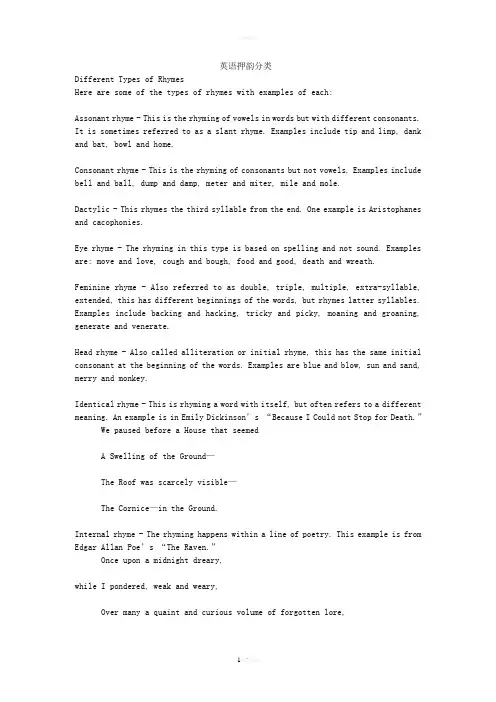
英语押韵分类Different Types of RhymesHere are some of the types of rhymes with examples of each:Assonant rhyme - This is the rhyming of vowels in words but with different consonants. It is sometimes referred to as a slant rhyme. Examples include tip and limp, dank and bat, bowl and home.Consonant rhyme - This is the rhyming of consonants but not vowels. Examples include bell and ball, dump and damp, meter and miter, mile and mole.Dactylic - This rhymes the third syllable from the end. One example is Aristophanes and cacophonies.Eye rhyme - The rhyming in this type is based on spelling and not sound. Examples are: move and love, cough and bough, food and good, death and wreath.Feminine rhyme - Also referred to as double, triple, multiple, extra-syllable, extended, this has different beginnings of the words, but rhymes latter syllables. Examples include backing and hacking, tricky and picky, moaning and groaning, generate and venerate.Head rhyme - Also called alliteration or initial rhyme, this has the same initial consonant at the beginning of the words. Examples are blue and blow, sun and sand, merry and monkey.Identical rhyme - This is rhyming a word with itself, but often refers to a different meaning. An example is in Emily Dickinson’s “Because I Could not Stop for Death.” We paused before a House that seemedA Swelling of the Ground—The Roof was scarcely visible—The Cornice—in the Ground.Internal rhyme - The rhyming happens within a line of poetry. This example is from Edgar Allan Poe’s “The Raven.”Once upon a midnight dreary,while I pondered, weak and weary,Over many a quaint and curious volume of forgotten lore,Light rhyme - Rhyming of syllable where one is stressed and the other is not. Examples include frog and dialog, mat and combat.Macaronic rhyme - This rhymes words from different languages. Examples are villa and manilla, amore and favor, sure and kreatur, lay and lei, sitar and guitar.Masculine rhyme - In this rhyme, the stress in on the final syllable in both words. Examples include support and report, dime and sublime, divulge and bulge.Near rhyme - Also referred to as half, slant, approximate, off, and oblique, this rhymes the final consonants but not the vowels or initial consonants. Examples are bent and rant, quick and back.Oblique - This is an imperfect rhyme because the sounds do not quite match. Sometimes these are called half, approximate, near, off, or slant rhymes. Examples are lap and shape, fiend and mean, gun and thumb.Perfect rhyme - Sometimes called exact, full or true, this rhyme is the typical rhyme where the ending sounds match. Examples are cat and hat, egg and beg, ink and pink, boo and true, soap and dope.Rich rhyme - In this case, the words are pronounced the same but have different meanings, like homonyms. Examples include raise and raze, break and brake, vary and very, lessen and lesson.Scarce rhyme - This refers to words that have very few other words that rhyme with them. Examples are lips and whisp, oceanless and motionless.Semirhyme - In this rhyme, one word has and extra syllable. Examples are mend and ending, rye and buying, lick and pickle.Syllabic - Rhyming the last syllable, this is also called tail or end rhyme. Examples include beaver and silver, dancing and prancing.Wrenched rhyme - This is an imperfect rhyme which rhymes a stressed with an unstressed syllable. Examples are caring and wing, lady and a bee.。
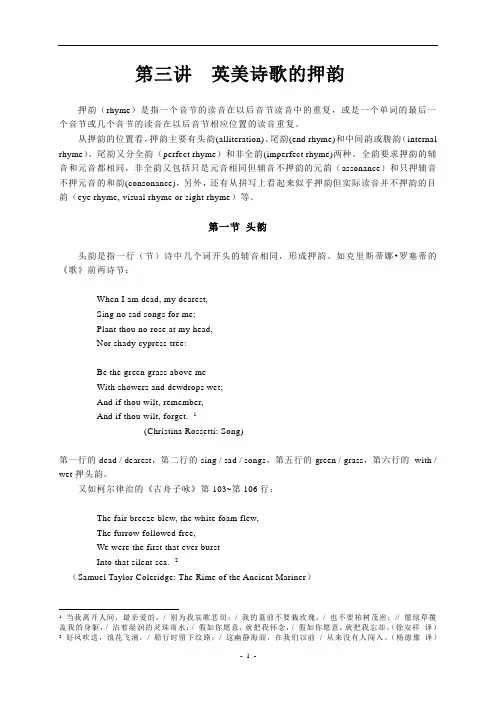
第三讲英美诗歌的押韵押韵(rhyme)是指一个音节的读音在以后音节读音中的重复,或是一个单词的最后一个音节或几个音节的读音在以后音节相应位置的读音重复。
从押韵的位置看,押韵主要有头韵(alliteration)、尾韵(end rhyme)和中间韵或腹韵(internal rhyme)。
尾韵又分全韵(perfect rhyme)和非全韵(imperfect rhyme)两种。
全韵要求押韵的辅音和元音都相同,非全韵又包括只是元音相同但辅音不押韵的元韵(assonance)和只押辅音不押元音的和韵(consonance),另外,还有从拼写上看起来似乎押韵但实际读音并不押韵的目韵(eye rhyme, visual rhyme or sight rhyme)等。
第一节头韵头韵是指一行(节)诗中几个词开头的辅音相同,形成押韵。
如克里斯蒂娜•罗塞蒂的《歌》前两诗节:When I am dead, my dearest,Sing no sad songs for me;Plant thou no rose at my head,Nor shady cypress tree:Be the green grass above meWith showers and dewdrops wet;And if thou wilt, remember,And if thou wilt, forget. 1(Christina Rossetti: Song)第一行的dead / dearest,第二行的sing / sad / songs,第五行的green / grass,第六行的with / wet押头韵。
又如柯尔律治的《古舟子咏》第103~第106行:The fair breeze blew, the white foam flew,The furrow followed free,We were the first that ever burstInto that silent sea. 2(Samuel Taylor Coleridge: The Rime of the Ancient Mariner)1当我离开人间,最亲爱的,/ 别为我哀歌悲切;/ 我的墓前不要栽玫瑰,/ 也不要柏树茂密;// 愿绿草覆盖我的身躯,/ 沾着湿润的灵珠雨水;/ 假如你愿意,就把我怀念,/ 假如你愿意,就把我忘却。
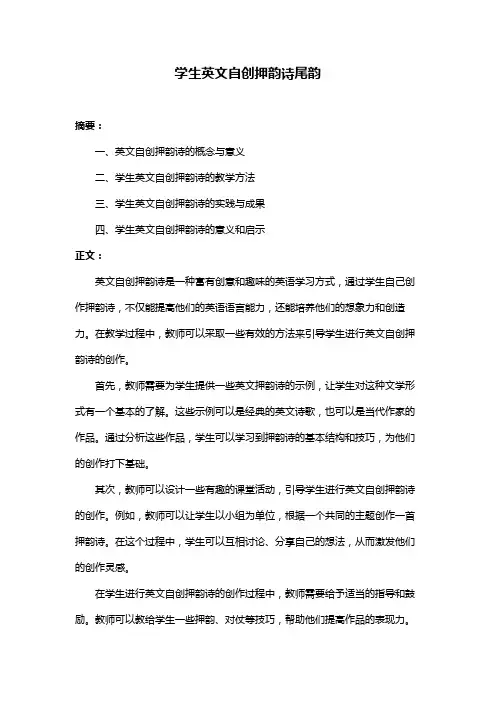
学生英文自创押韵诗尾韵
摘要:
一、英文自创押韵诗的概念与意义
二、学生英文自创押韵诗的教学方法
三、学生英文自创押韵诗的实践与成果
四、学生英文自创押韵诗的意义和启示
正文:
英文自创押韵诗是一种富有创意和趣味的英语学习方式,通过学生自己创作押韵诗,不仅能提高他们的英语语言能力,还能培养他们的想象力和创造力。
在教学过程中,教师可以采取一些有效的方法来引导学生进行英文自创押韵诗的创作。
首先,教师需要为学生提供一些英文押韵诗的示例,让学生对这种文学形式有一个基本的了解。
这些示例可以是经典的英文诗歌,也可以是当代作家的作品。
通过分析这些作品,学生可以学习到押韵诗的基本结构和技巧,为他们的创作打下基础。
其次,教师可以设计一些有趣的课堂活动,引导学生进行英文自创押韵诗的创作。
例如,教师可以让学生以小组为单位,根据一个共同的主题创作一首押韵诗。
在这个过程中,学生可以互相讨论、分享自己的想法,从而激发他们的创作灵感。
在学生进行英文自创押韵诗的创作过程中,教师需要给予适当的指导和鼓励。
教师可以教给学生一些押韵、对仗等技巧,帮助他们提高作品的表现力。
同时,教师要对学生的作品给予充分的肯定和鼓励,让他们更有信心地进行创作。
通过英文自创押韵诗的创作,学生不仅可以提高自己的英语水平,还可以培养自己的审美情趣和文学素养。
此外,这种创作方式还可以增进学生之间的友谊,培养他们的团队协作能力。
总之,英文自创押韵诗是一种富有成效的英语教学方法。
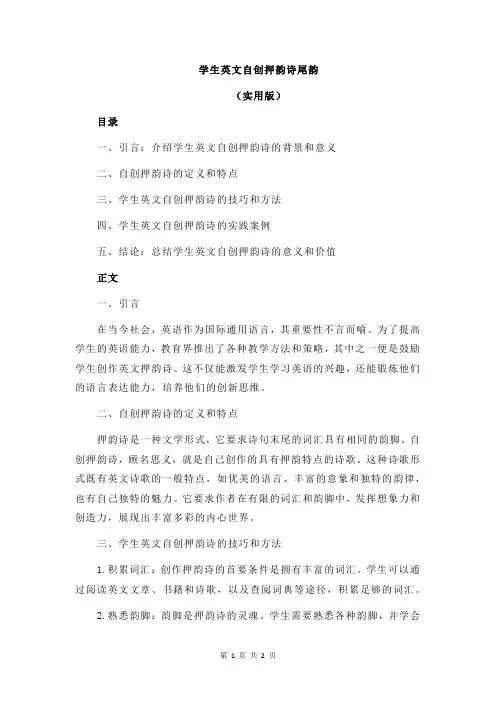
学生英文自创押韵诗尾韵(实用版)目录一、引言:介绍学生英文自创押韵诗的背景和意义二、自创押韵诗的定义和特点三、学生英文自创押韵诗的技巧和方法四、学生英文自创押韵诗的实践案例五、结论:总结学生英文自创押韵诗的意义和价值正文一、引言在当今社会,英语作为国际通用语言,其重要性不言而喻。
为了提高学生的英语能力,教育界推出了各种教学方法和策略,其中之一便是鼓励学生创作英文押韵诗。
这不仅能激发学生学习英语的兴趣,还能锻炼他们的语言表达能力,培养他们的创新思维。
二、自创押韵诗的定义和特点押韵诗是一种文学形式,它要求诗句末尾的词汇具有相同的韵脚。
自创押韵诗,顾名思义,就是自己创作的具有押韵特点的诗歌。
这种诗歌形式既有英文诗歌的一般特点,如优美的语言、丰富的意象和独特的韵律,也有自己独特的魅力。
它要求作者在有限的词汇和韵脚中,发挥想象力和创造力,展现出丰富多彩的内心世界。
三、学生英文自创押韵诗的技巧和方法1.积累词汇:创作押韵诗的首要条件是拥有丰富的词汇。
学生可以通过阅读英文文章、书籍和诗歌,以及查阅词典等途径,积累足够的词汇。
2.熟悉韵脚:韵脚是押韵诗的灵魂。
学生需要熟悉各种韵脚,并学会在不同的场合运用适当的韵脚。
3.掌握节奏:押韵诗的节奏很重要,学生应该学会通过调整诗句的长度和音节,把握诗歌的节奏感。
4.立意:有了好的立意,诗歌才能引人入胜。
学生应该学会从生活、学习、社会等方面取材,以独特的视角展现自己的思考。
四、学生英文自创押韵诗的实践案例以下是一首学生创作的英文押韵诗:In the quiet night,The stars shine bright,A gentle breeze blows,Bringing dreams to you.This poem, though simple,Reflects the student"s feeling,About the night and its charm,In a unique way.五、结论学生英文自创押韵诗,不仅有助于提高学生的英语水平,还能锻炼他们的思维能力和创新精神。
英语押韵分类Different Types of RhymesHere are some of the types of rhymes with examples of each:Assonant rhyme - This is the rhyming of vowels in words but with different consonants. It is sometimes referred to as a slant rhyme. Examples include tip and limp, dank and bat, bowl and home.Consonant rhyme - This is the rhyming of consonants but not vowels. Examples include bell and ball, dump and damp, meter and miter, mile and mole.Dactylic - This rhymes the third syllable from the end. One example is Aristophanes and cacophonies.Eye rhyme - The rhyming in this type is based on spelling and not sound. Examples are: move and love, cough and bough, food and good, death and wreath.Feminine rhyme - Also referred to as double, triple, multiple, extra-syllable, extended, this has different beginnings of the words, but rhymes latter syllables. Examples include backing and hacking, tricky and picky, moaning and groaning, generate and venerate.Head rhyme - Also called alliteration or initial rhyme, this has the same initial consonant at the beginning of the words. Examples are blue and blow, sun and sand, merry and monkey.Identical rhyme - This is rhyming a word with itself, but often refers to a different meaning. An example is in Emily Dickinson’s “Because I Could not Stop for Death.”We paused before a House that seemedA Swelling of the Ground—The Roof was scarcely visible—The Cornice—in the Ground.Internal rhyme - The rhyming happens within a line of poetry. This example is from Edgar Allan Poe’s “The Raven.”Once upon a midnight dreary,while I pondered, weak and weary,Over many a quaint and curious volume of forgotten lore,Light rhyme - Rhyming of syllable where one is stressed and the other is not. Examples include frog and dialog, mat and combat.Macaronic rhyme - This rhymes words from different languages. Examples are villa and manilla, amore and favor, sure and kreatur, lay and lei, sitar and guitar.Masculine rhyme - In this rhyme, the stress in on the final syllable in both words. Examples include support and report, dime and sublime, divulge and bulge.Near rhyme - Also referred to as half, slant, approximate, off, and oblique, this rhymes the final consonants but not the vowels or initial consonants. Examples are bent and rant, quick and back.Oblique - This is an imperfect rhyme because the sounds do not quite match. Sometimes these are called half, approximate, near, off, or slant rhymes. Examples are lap and shape, fiend and mean, gun and thumb.Perfect rhyme - Sometimes called exact, full or true, this rhyme is the typical rhyme where the ending sounds match. Examples are cat and hat, egg and beg, ink and pink, boo and true, soap and dope.Rich rhyme - In this case, the words are pronounced the same but have different meanings, like homonyms. Examples include raise and raze, break and brake, vary and very, lessen and lesson.Scarce rhyme - This refers to words that have very few other words that rhyme with them. Examples are lips and whisp, oceanless and motionless.Semirhyme - In this rhyme, one word has and extra syllable. Examples are mend and ending, rye and buying, lick and pickle.Syllabic - Rhyming the last syllable, this is also called tail or end rhyme. Examples include beaver and silver, dancing and prancing.Wrenched rhyme - This is an imperfect rhyme which rhymes a stressed with an unstressed syllable. Examples are caring and wing, lady and a bee.。
常用韵脚大全a篇:Ba:八,把,吧,爸,罢,巴,扒,坝,霸,靶,笆,疤Ca:擦,Cha:查,插,叉,茶,差,杈Da:大,答,达,打,搭Fa:发,法,罚,伐,乏Ga:尬Ha:哈Ka:卡La:拉,啦,辣,蜡,腊(希腊)Ma:吗,妈,马,嘛,麻,骂,码(几码)Na:那,拿,哪,衲Pa:怕,爬,趴,琶,葩Sa:撒,洒,仨Sha:杀,沙,啥,纱,傻,砂,煞Ta:他,她,它,踏,塔,塌,蹋,榻(床榻)Wa:挖,瓦,蛙,哇,娃,洼,袜Ya:呀,压,牙,芽,鸭,崖,哑,涯,亚,丫,雅,讶,鸦Za:杂,砸,咋,扎Zha:扎,炸,渣,闸,眨,榨,乍,诈,札,ia篇:Dia:嗲Jia:家,加,假,价,架,甲(路人甲),佳,嘉,夹,驾,嫁,葭(兼葭--芦苇,兼葭苍苍)Lia:俩Qia:恰,卡(发卡),掐Xia:下,吓,夏,峡,虾,瞎,霞,匣,狭,侠,辖ua篇:Gua:挂,刮,瓜,寡,卦,褂Hua:话,花,化,画,划,华,滑,猾,哗Kua:跨,夸,垮Shua:刷,耍Zhua:抓,爪e篇:Ce:册,侧,策,厕,测Che:车,撤,扯,澈De:的,德Ge:个,歌,割,哥,搁,格,隔,阁,革(牛皮革),鸽He:和,喝,合,河,禾,核(杏核),何,荷,贺,赫,褐,盒,鹤,菏,阂,涸,吓Ke:可,克,棵,科,颗,刻,课,客,壳,渴,磕,咳,坷Le:了,乐,勒,肋Me:么Ne:呢Re:热,惹Se:色,涩,塞,瑟,啬She:社(琵琶社),射,蛇,设,舌,舍,折,涉,奢Te:忑,特Ye:也,夜,业,野,叶,爷,页,液,冶,噎(一个人噎),咽,靥Ze:则,责,择,泽,咋Zhe:着,这,者,折,遮,蛰(被蛰),辙,蔗o篇:Bo:波,拨,播,泊,博,驳,剥,伯,薄,柏,铂,箔Fo:佛Mo:磨,摸,末,墨,没,莫,沫,默,抹,魔,摹,摩,脉,寞Po:破,坡,婆,颇,泼,迫,魄,泊,Wo:我,握,窝,卧Yo:哟uo篇:Cuo:错,撮Chuo:戳,龊Duo:多,朵,夺,舵,堕,惰,躲,踱(来回走)Guo:过,国,果,裹,锅,郭Huo:或,活,火,伙,货,获,祸,惑,霍(挥霍)Kuo:阔,扩,括,廓Luo:落,罗,裸,骡,螺,萝,箩,烙,络,逻,洛Nuo:挪,诺,娜Ruo:若,弱,箬(竹,或竹叶)Suo:所,缩,锁,索,蓑,娑Shuo:说,硕,烁,朔Tuo:拖,脱,托,妥,拓,唾,佗Zuo:做,作,坐,左,座,凿Zhuo:捉,桌,啄,着,拙,灼,浊,酌,ie篇:Bie:别,憋Die:跌,叠,爹,碟,蝶,迭Jie:解,节,接,借,皆,截,界,结,街,届,姐,揭,戒,阶,劫,竭,洁,杰,秸,睫,颉(仓颉)Lie:列,裂,烈,劣,猎Mie:灭,蔑Nie:捏,孽,涅Pie:瞥,撇Qie:切,且,怯,窃,茄,砌,妾,Tie:帖,贴Xie:写,些,鞋,斜,血,卸,挟,屑,懈,泻,泄,邪,谢ue篇:Jue:决,绝,觉,角,爵,诀,撅,嚼,厥,獗Nue:虐Lue:略,掠Que:却,缺,确,雀,瘸,鹊,阕,阙Xue:学,雪,血,靴,穴,削Yue:月,越,约,跃,阅,乐,岳,悦,曰u篇:Bu:不,步,补,布,部(情字部),簿,捕,怖Cu:粗,醋,簇,蹙(蹙眉)Chu:出,处,初,锄,触,除,橱,楚,础,储,厨,畜,躇(踟躇)Du:读,度,毒,渡,独,堵,肚,赌,镀,睹,督,杜,妒Fu:幅,浮,扶,福,富,负,伏,服,复,附,斧,夫,父,符,府,腐,腹,妇,抚,赋,赴,覆,肤,袱,芙Gu:古,谷,鼓,故,孤,箍,姑,顾,固,雇,骨,辜,菇Hu:湖,户,呼,虎,壶,胡,护,糊,弧,忽,狐,蝴,葫,乎,瑚Ju:句,举,巨,局,居,剧,拘,聚,菊,掬,裾(敛裾:裙)Ku:哭,苦,枯,裤,酷,窟Lu:路,鹿,陆,炉,录Mu:木,母,幕,目,墓,牧,慕,暮Nu:怒,奴Pu:扑,谱Qu:去,取,区,娶,曲,趣,污,驱,躯,蛆,觑(相觑)Ru:如,入,汝,儒,乳,辱,褥Su:素,速,诉,塑,宿,俗,苏,肃,酥,簌(簌簌)Shu:书,树,数,熟,输,梳,叔,属,束,术,述,殊,抒,舒Tu:土,图,兔,涂,吐,徒Wu:无,屋,五,物,舞,雾,误,污,悟,勿,武,吴,午,吾,恶,芜,坞Xu:许,须,需,虚,序,叙,婿,绪,墟Yu:与,于,欲,鱼,雨,余,遇,语,玉,愚,羽,喻,域,郁,娱Zu:组,族,足,祖,租Zhu:主,住,猪,竹,煮,筑,珠,朱,烛,柱,祝,铸i篇:Bi:比,笔,闭(红颜闭),鼻,碧,逼,壁,币,蔽,弊,痹Ci:次,此,词,瓷,慈,雌,刺,疵,赐Chi:吃,尺,迟,池,痴,赤,齿,耻,持,斥,侈Di:地,第,底,低,敌,滴,帝,递,弟,笛Li:里,离,力,立,李,例,理,利,梨,厘(几厘),礼,历,丽,篱,荔,厉,砾,励,粒,隶,璃,黧(意:黑词:面目黧)Mi:米,密,迷,蜜,谜,觅,秘Ni:你,泥,腻,逆,睨(眼睨)Pi:皮,批,匹,披,劈Qi:起,七,气,期,齐,器,妻,骑,棋,奇,欺,漆,启,岂,砌,弃,泣,凄,乞,旗Ri:日Si:四,死,丝,撕,似,私,思,寺,肆Shi:是,使,十,时,事,室,市,师,石,史,试,失,式,尸,诗,湿,施,拾,实,屎,始,示,虱,蚀,实,士,世,誓,噬,释,饰,侍,视,食,似,氏,适,匙,识Ti:体,替,提,题,踢,蹄,梯,啼,涕,屉Xi:西,洗,细,吸,戏,系,喜,席,稀,溪,熄,膝,袭,息,惜习,夕,悉,昔,媳,兮,析,隙,栖,皙,玺Yi:一,以,已,衣,亿,移,依,易,医,乙,仪,亦,椅,益,倚,姨,翼,译,伊,疑,意,怡,弈,异,役,矣,艺,忆,溢,义Zi:字,自,子,紫,籽,姿Zhi:只,之,直,知,制,指,纸,支,枝,脂,汁,织,址,止,值,旨,志,至,致,置,智,值,质,滞,治,痣ai篇:Bai:百,百,败,柏,拜,摆Cai:才,菜,采,材,裁,裁,猜,踩,睬,彩Chai:差,柴,拆,钗Gai:改,该,丐,概,盖Hai:还,害,海,骸,孩Kai:开,铠Lai:来,赖,睐Mai:买,卖,埋,麦,脉,霾,迈Nai:乃,奶,耐,奈Pai:派,排,拍(慢了一拍),牌,徘,湃Sai:腮,赛Tai:台,太,汰,胎,苔Wai:外,歪Zai:再,在,灾,载,栽,宰,仔,哉Zhai:摘,窄,债,斋,宅ai:爱,哀,碍,埃uai篇:Guai:怪,拐,乖Huai:坏,怀,淮,槐,徊,踝Kuai:快,块,筷,Shuai:帅,摔,甩,衰ei篇:Bei:北,杯,背,碑,悲,惫Fei:非,飞,费,肥,妃,扉Gei:给Hei:黑Lei:类,泪,累,雷,磊,儡Mei:没,每,美,妹,眉,枚,霉,梅,媚,昧,媒,煤,酶Nei:内Wei:味,位,帏,微,卫,危,违,苇,尾,慰,偎,伪Pei:配,陪,赔,佩Zei:贼Zhei:这Shei:谁Ei:诶uei(ui)篇:Cui:脆,催,摧,翠,悴,啐Chui:吹,垂,炊,陲,槌,椎Dui:对,队,堆,怼(意:怨恨词:针针怨怼)Gui:归,贵,鬼,跪,轨,规,桂,柜,龟,诡,闺,瑰Hui:会,回,汇,灰,绘,挥,毁,悔,辉,晦,惠,秽,慧,讳,徊kui:亏,愧,窥,盔,葵,傀,溃Rui:蕊,瑞,睿,蕊Sui:岁,虽,随,碎,髓Shui:水,谁,睡,税Tui:推,腿,退,颓,蜕Zui:最,罪,醉,嘴,Zhui:追,坠,缀,锥ao篇:Bao:包,保,报,宝,抱,暴,苞,褓,剥,雹,褒,堡,爆Chao:朝,抄,超,吵,巢,潮,炒,嘲,Dao:到,道,倒,刀,岛,盗,稻,悼,导,蹈,祷,捣Gao:高,搞,告,稿,膏,篙,羔,糕Hao:好,号,豪,毫,嚎Kao:靠,考,烤,拷Lao:老,捞,牢,劳Mao:毛,冒,帽,猫,貌,矛,锚Nao:闹,脑,恼,瑙Pao:跑,抛,炮,泡,袍Rao:饶,绕,扰,娆Sao:扫,嫂,骚(离骚)Shao:少,烧,梢,勺Tao:套,掏,逃,桃,讨,淘,涛,滔,陶,萄Yao:要,摇,药,咬,眺,妖,邀,窑,谣,遥,瑶(美,美玉),腰,耀Zao:早,造,灶,凿,遭,澡,藻,蚤,枣Zhao:着,找,照,招,朝,爪,兆,赵Ao:袄,凹,傲,奥,熬,懊,翱,iao篇:Biao:表,标,镖,婊,膘Diao:掉,调,钓,吊,雕,貂,Jiao:叫,脚,交,角,教,较,缴,觉,焦(聚焦),胶,娇,绞,校,搅,骄,狡,嚼,蕉,椒,礁,酵,饺,窖Liao:了料,聊,疗,寥Miao:秒,描,秒,庙Niao:鸟,袅Piao:票,飘,漂,瓢Qiao:桥,瞧,敲,巧,翘,壳,悄,俏,窍,乔,憔Xiao:小,笑,消,削,萧,宵,晓,孝,啸,霄,哮,潇,箫ou篇:Cou:凑Chou:抽,愁,臭,仇,丑,绸,筹,踌Dou:都,斗,豆,陡,兜,抖Fou:否Gou:够,沟,狗,钩,勾,购,垢,构Hou:后,厚,吼,喉,候,逅Kou:口,扣Lou:楼,搂,漏,陋,露,篓,髅Mou:某,谋,眸Pou:剖Shou:手,受,收,首,瘦,守,兽,售,熟,寿Tou:头,偷,透,投You:有,又,友,右,油,游,幼,优,忧,犹,诱,悠,邮,幽,佑,由Zou:走,奏,揍Zhou:周,洲,皱,粥,州,轴,舟,昼,咒,宙,骤Ou:偶,欧,藕iu篇:Diu:丢Jiu:就,九,酒,旧,久,揪,救,纠,究,疚Liu:六,流,留,柳,溜,榴,琉Miu:谬Niu:牛,妞Qiu:求,球,秋,丘,囚Xiu:修,锈,绣,休,羞,宿,嗅,袖,秀,朽an篇:Ban:办,半,般,班,拌,搬,板,伴,瓣Can:蚕,残,参,惨,惭,餐,灿Chan:产,颤,蝉,馋,潺,婵,禅,忏Dan:但,单,蛋,担,弹,掸,胆,丹,诞,郸,淡,旦Fan:反,饭,翻,犯,番,凡,帆,返,泛,繁,烦,范,泛,梵Gan:感,干,敢,赶,竿,甘,肝,杆Han:喊,含,汗,寒,汉,旱,酣,涵,函,憨,翰,悍,罕,鼾Kan:看,坎,槛,侃Lan:兰,蓝,烂,拦,篮,栏,揽,懒,滥,婪,澜,榄,览,褴Man:满,慢,蛮,埋,漫Nan:难,南,男Pan:盘,盼,攀,判,畔Ran:染,燃,然,冉San:三,伞,散Shan:山,闪,衫,善,杉,扇Tan:谈,叹,探,滩,弹,碳,潭,摊,贪,坛,痰,毯,坦,炭,瘫,檀,昙Wan:完,晚,万,弯,湾,丸,碗,挽,腕,宛,婉,娩Yan:眼,烟,沿,盐,言,演,严,咽,淹,掩,厌,岩,研,延,堰,验,焉,颜,艳,燕,砚,雁,焰,嫣,檐Zan:赞,攒,簪Zhan:站,占,战,盏,沾,粘,展,瞻,斩,辗,栈,绽An:安,岸,暗,案,庵,鞍,按ian篇:Bian:边,变,便,遍,编,辩,扁,鞭,辫,匾Dian:点,电,店,殿,淀,颠,奠,惦,典,巅Jian:见,件,减,尖,间,贱,肩,兼,建,箭,简,剪,剑,笺(意:信笺),茧,拣,鉴,谏Lian:连,联,练,莲,恋,脸,怜,廉,帘Mian:面,免,棉,绵,眠Nian:年,念,粘Pian:片,篇,骗,偏Qian:前,钱,千,牵,浅,签,欠,铅,纤,歉,倩Tian:天,田,添,填,甜,腆Xian:先,线,县,现,显,掀,闲,献,嫌,陷,险,鲜,弦,涎,羡,仙,贤,鲜u(ü)an篇:Cuan:窜Chuan:穿,船,传,串,川Duan:段,短,断,端Guan:关,观,惯,灌,冠,棺Huan:换,还,唤,环,患,缓,欢,幻Juan:卷,绢,娟Kuan:宽,款Luan:乱,卵,鸾Nuan:暖Quan:全,权,全,犬,泉,拳Ruan:软Suan:酸,算,蒜Shuan:栓,闩Tuan:团Yuan:远,员,元,院,圆,原,愿,园,怨,冤,缘,源Zuan:钻,纂,赚Zhuan:转,专,砖,传,篆,撰en篇:Ben:本,奔,笨Chen:臣,辰,称,晨,尘,沉,陈,嗔Fen:分,份,粉,坟,奋,愤,纷,忿(意:怨恨)Gen:跟,根,亘Hen:很,狠,恨,痕Ken:肯,垦Men:门,们,闷Nen:嫩,恁Pen:喷,盆Ren:人,忍,任,认,刃,仁,韧Sen:森Shen:身,深,伸,婶,审,什(迁就什)Wen:问,文,闻,温,稳,吻,蚊,纹,刎Zen:怎Zhen:真,阵,针,镇,枕,贞En:恩in篇:Bin:宾,鬓Jin:进,近,今,仅,紧,金,斤,尽,劲,禁,浸,锦,襟,巾,衿(青青子衿)Lin:林,临,邻,淋,鳞,粼Nin:您Pin:品,贫,拼,颦Qin:亲,琴,侵,寝,秦Xin:新,心,信,辛,衅Yin:因,引,印,银,音,阴,饮,隐,吟,姻un(ün)+ un篇:Cun:村,寸,存Chun:春,唇,纯,蠢,醇,淳Dun:吨,蹲,盾,遁Gun:滚,棍Hun:混,昏,荤,浑,婚,魂Jun:军,君,菌Kun:困,捆,坤Lun:论,轮Qun:群,裙Run:润Sun:孙,损,笋Shun:顺,吮,瞬Tun:吞Xun:寻,熏,讯,训,殉,巡,勋,醺,曛Yun:云,晕,运,,韵,匀,孕,陨,蕴,酝Zun:尊(一尊)Zhun:准ang篇:Bang:帮,棒,绑,邦Cang:藏,仓,舱Chang:长,唱,常,场,尝,肠,畅,敞,伥,怅Dang:当,党,挡,荡Fang:放,房,防,芳,纺,方,访,仿,坊(XX坊)Gang:纲,缸Hang:行,巷,航Kang:炕,抗,扛,康Lang:浪,狼,廊,朗,郎Mang:忙,盲,茫Nang:囊Pang:旁,胖Rang:让Sang:丧,桑Shang:上,伤,尚,商,裳,觞Tang:堂,躺,糖,汤,烫,淌,唐,棠,傥Wang:望,忘,王,往,网,亡,枉,惘Yang:样,养,羊,洋,氧,痒,杨,阳,漾,殃,央(夜未央),鸯Zang:葬,脏,奘Zhang:张,章,长,丈,掌,涨,杖,账,障iang篇:Jiang:将,讲,江,奖,降,匠Liang:两,亮,辆,凉,粮,梁,量,良,谅,靓Niang:娘,酿Qiang:强,抢,墙,腔Xiang:想,向,香,乡,像,相,响,箱,巷,厢,降,详,饷(半饷)uang篇:Chuang:窗,床,闯,创,疮Guang:光,广,逛Huang:黄,慌,晃,荒,凰,皇,谎,恍,徨Kuang:矿,筐,狂Shuang:双,霜,爽Zhuang:装,撞,庄,壮,状,妆eng篇:Beng:蹦,绷ceng:曾,层Cheng:成,乘,撑,称,程,城,诚,秤,丞Feng:风,封,逢,缝,枫,丰,疯,奉,讽,凤,峰,锋Geng:更(三更)Heng:横,恒,哼,行Keng:坑Leng:冷,棱,楞,愣Meng:梦,猛,蒙,孟,盟Neng:能Peng:碰,捧,砰,蓬,烹,棚,篷Reng:扔Seng:僧Sheng:声,省,生,剩,绳,升,绳,盛,胜,圣Teng:疼,藤Weng:翁,瓮Zeng:增,赠,憎,曾Zheng:正,整,睁,争,征,证,蒸,筝ing篇:Bing:并,病,兵,冰,丙,饼,柄Ding:顶,定,盯,鼎,订Jing:静,井,惊,经,镜,京,净,敬,精,景,警,境,径,颈,劲Ming:名,明,命,鸣,茗Ning:凝Ping:平,瓶,屏Qing:请,轻,清,青,情,晴,庆,亲Ting:听,停,亭,庭Xing:性,行,型,星,形,醒,姓,腥,刑,杏,兴,幸Ying:应,硬,影,映,英,颖,盈,樱,婴,嬴ong篇:Cong:从,丛,匆,聪Chong:冲,重,虫,宠Dong:动,东,懂,洞,冻,冬Gong:工,公,功,共,弓,攻,宫,贡Hong:红,虹,泓Kong:空,孔Long:龙,笼,聋,弄Nong:浓,农,侬Qiong:穷,琼,跫Rong:容,融,溶,熔,蓉Song:送,松,宋,颂,讼,怂(惊)Tong:同,通,痛,铜,桶,筒,捅,童,彤,桐,瞳Xiong:胸,雄,凶,兄Yong:用,涌,永,拥,勇,蛹,咏,俑Zong:总,纵,宗,踪,鬃,粽Zhong:中,重,种,钟,众,忠,终,冢。
【网络综合 - 英语口语】中国人和外国人有一点很像,就是许愿,在美国不论在何处看到大大小小的池子,里面多半有许愿人所丢的铜板。
不过老美许愿的方式和我们不太一样。
(但是小气是一样的,都是面额最小的 1cent 居多),正确的许愿方式是: Throw coin over your shoulder. 也就是说,你要背对池子,把铜板从你的肩膀上丢到池子里,下次再去许愿时不要忘了喔。
在这一集笔记中,我特别挑出一些念起来有押韵而且在日常生活中常常会用到的一些词汇,希望各位会喜欢。
1. I just had a super-duper meal in the resturant.我刚刚在餐厅吃了一顿超级大餐。
Super-duper 是一种加强语法的说法,程度上比 Super 还要再高一级。
比方说我要跟老美说我的网页有多棒,我就可以说, Welcome to my super-duper website!所以建议一下综艺节目 Super Suday 改名成 Super-duper sunday 可能会有助于收视率的提升。
2. I can't believe you said this is a tiny-little mistake.我不敢相信你说这是微不足道的错误。
跟 Super-duper 正好对等,当你要特别强调某件东西很小很小时,就可以用tiny-little 来形容。
比方说蚂蚁好了,你就可以用 tiny-little 来形容,例如: Hey!Look at those tiny-little creatures. 不过我最常听到的tiny-little 多半是跟mistake 连用。
一个人为了强调自己犯的错其实没什么大不了的,就可以说 It is just a tiny-little mistake.3. Stick and stone.我不认为你的话会伤了我。
这是一句很长的英文句子的开头,原文是这样的。
浅析英语诗歌——结构韵律篇一、诗歌的结构结构主要是指诗的三个主要特点,一是语音组合模式二是口语重音模式三是一定的语体形式诗歌的语音组合模式是指英语诗歌的语音是如何被诗人运用,组合以形成一些常用的或固定的语音模式,如压韵(rhyme),头韵(alliteration),元音韵(assonance),辅音韵(consonance),倒压韵(reverse rhyme),行内韵(internal rhyme)等。
诗歌口语重音模式是指诗人根据单词重音,短语重音,句子重音创造出一定的节奏(rhythm)。
在诗歌中称为格律或韵律(meter)。
格律由音步(foot)构成;英语中的音步有不同类型。
注意:音步指的是一行诗内的节奏,在划分英语诗歌音步的时候我们用这样的标识V \ 来分别标识非重读音节和重读音节,音节的划分主要通过朗读,根据诗的音节为单位划分,而不是整个单词,比如一个英文单词,literature,有四个音节。
扬及重读音节,抑及非重读。
在划分音步的时候要先把一句诗的全部音节划出来,然后按照语义和重音朗读就会得出下面的这几种不同的格律了。
(关于这部分的详细解释和例子请参见英诗解析一文)1. 抑扬格(iamb)由一个非重读音节和一个重读音节组成V \2. 扬抑格(trochee)由一个重读音节和一个非重读音节组成 \ V3. 扬抑抑格(dactyl)由一个重读音节和两个非重读音节组成 \ VV4. 抑抑扬格(anapest)由两个非重读音节和一个重读音节组成 V V \5. 扬扬格(spondee)由两个重读音节构成 \ \6. 抑抑格(pyrrhic)由两个非重读音节构成 V V按音步的多少又可分为:单音步(monometer), 双音步(diameter),三音步(trimeter),四音步(tetrameter),五音步(pentermeter),六音步(hexameter),七音步(heptameter),八音步(octameter)。
第三讲英美诗歌的押韵押韵(rhyme)是指一个音节的读音在以后音节读音中的重复,或是一个单词的最后一个音节或几个音节的读音在以后音节相应位置的读音重复。
从押韵的位置看,押韵主要有头韵(alliteration)、尾韵(end rhyme)和中间韵或腹韵(internal rhyme)。
尾韵又分全韵(perfect rhyme)和非全韵(imperfect rhyme)两种。
全韵要求押韵的辅音和元音都相同,非全韵又包括只是元音相同但辅音不押韵的元韵(assonance)和只押辅音不押元音的和韵(consonance),另外,还有从拼写上看起来似乎押韵但实际读音并不押韵的目韵(eye rhyme, visual rhyme or sight rhyme)等。
第一节头韵头韵是指一行(节)诗中几个词开头的辅音相同,形成押韵。
如克里斯蒂娜•罗塞蒂的《歌》前两诗节:When I am dead, my dearest,Sing no sad songs for me;Plant thou no rose at my head,Nor shady cypress tree:Be the green grass above meWith showers and dewdrops wet;And if thou wilt, remember,And if thou wilt, forget. 1(Christina Rossetti: Song)第一行的dead / dearest,第二行的sing / sad / songs,第五行的green / grass,第六行的with / wet押头韵。
又如柯尔律治的《古舟子咏》第103~第106行:The fair breeze blew, the white foam flew,The furrow followed free,We were the first that ever burstInto that silent sea. 2(Samuel Taylor Coleridge: The Rime of the Ancient Mariner)1当我离开人间,最亲爱的,/ 别为我哀歌悲切;/ 我的墓前不要栽玫瑰,/ 也不要柏树茂密;// 愿绿草覆盖我的身躯,/ 沾着湿润的灵珠雨水;/ 假如你愿意,就把我怀念,/ 假如你愿意,就把我忘却。